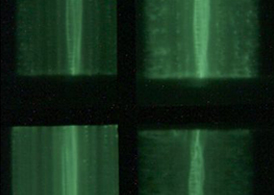
During our experiments we have developed a number of diagnostics, one of the most useful of which are XUV (extreme-ultraviolet, light with a photon energy of (10–100 eV) imaging cameras. Optical techniques, such as laser interferometry and shadowgraphy, are limited by the high density, temperature, and turbulence of plasma in arrays.Typically absorption and refraction effects mean quantitative information can only be gathered on the coronal plasma in the region between the wire cores and the array axis, where electron densities are 1018 cm−3. Conversely, more usual x-ray imaging techniques, such as time integrated/resolved pin-hole cameras, mainly provide information on plasma at the axis of the array—either the precursor column or the plasma at stagnation of the array—where temperatures are relatively high (100 eV). To gain information on the wire cores during ablation, x-ray radiography has been used, with an X-pinch providing probing radiation. This has resulted in measurements of the size of the wire cores, but the hardness of the probing radiation means that information on any core-corona interactions is difficult to obtain due to a lack of contrast. In addition, the time of probing is extremely difficult to control using X-pinches. Although a very simple technique, the application of XUV imaging to wire array experiments can provide significant information on all plasma dynamics. XUV imaging allows the ablation of plasma in a region very close to the wire cores to be directly studied. It also allows the entire implosion of an array to be followed, perhaps indicating the path of current in the system and the amount of any material left behind—both vital factors in determining the characteristics of the x-ray pulse.
Microchannel plates (MCPs) have a resolution of ,70 mm, and is capable of imaging radiation from 7 eV upward. The MCPs are divided into four independent gated areas, and four pinholes, mounted on a central late, image the pinch onto each “frame,” of the detector. The power supply to the MCP produces a gate voltage of up to 12 kV with a gate time of ,2 ns or greater, determined via a simple cable reflection. The length of cable from the power supply to each frame on the MCP controls the interframe time–low attenuation RM43 coax allows times of .30 ns with a minimal loss of gating voltage (,20% between frames 1 and 4). Two different XUV cameras are commonly fielded on MAGPIE and COBRA. A system with p=75.5 cm and q=41 cm, results in a magnification of 0.54, which allows the entire array to be viewed on each frame of the MCP. Using a pinhole of 100 mm diameter the smallest object size resolvable due to diffraction becomes comparable to that due to geometry (>280 mm) for incident radiation .40 eV. The entire history of the array, from initial wire ablation, through snowplough implosion until stagnation, can be followed by this arrangement. A second system with p=23 cm, q=96 cm, and again 100 mm produces a magnification of 4.3, and diffraction effects become comparable to geometry effects ,120 mmd when incident radiation is .30 eV. With this higher magnification, an additional set of apertures is required to prevent overlapping of the images on the MCP. This camera is used to study the coronal plasma ablating from the wire cores as shown.

